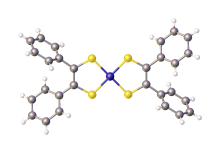Non-innocent ligand
In chemistry, non-innocent ligands , or non-innocent ligands , denote a certain type of ligand which, in complex compounds - especially with transition metals - means that the oxidation state of the central atom cannot be determined.
history
Complexes with non-innocent ligands have been known since the 1960s. At that time, square-planar dithiol bonds were synthesized to nickel , palladium and platinum . However, the term has only been more widespread since the 1990s, as these complexes have only attracted greater attention since then, which is mainly due to their redox properties.
definition
The term was introduced in 1966 by Christian Klixbüll Jørgensen . He defined it as follows: "Ligands are innocent when they allow oxidation states of the central atoms to be defined." , which in English means something like: "A ligand is innocent if it enables the oxidation state of the central atom to be clearly determined."
This means that if a metal forms a bond with a non-innocent ligand, the physical oxidation state of the central atom can no longer be determined (not to be confused with the formal oxidation state ).
Physical oxidation state
Explanation
The physical oxidation state describes the actual electronic state and can be examined spectroscopically , which is why it is often referred to as the spectroscopic oxidation state. Although it often corresponds to the formal oxidation state, this does not necessarily have to be the case. In the case of radical organic ligands in particular , the formal and physical oxidation states differ.
The radical phenoxy ligand in a complex with iron in the d5 configuration serves as an example . If the formal oxidation state is now determined, the ligand with the closed-shell configuration must be removed. To do this, it is not enough to just leave the binding pair of electrons to the ligand; the iron atom must also donate an electron from its d shell so that the phenoxy ligand is no longer present as a radical. This gives the iron d4 configuration, i.e. it is charged four times after the ligand has been removed and thus receives the formal oxidation state + IV. However, spectroscopic examinations show a physical oxidation state of + III.
Investigation methods
The following are used to directly determine the physical oxidation state:
- Atomic absorption spectroscopy
- Photoelectron Spectroscopy (PE) and X-ray Photoelectron Spectroscopy (XPS),
- Mössbauer spectroscopy
- NMR spectroscopy
Problem determining
In complexes with non-innocent ligands there are only minor energetic differences between the HOMO (d (π) orbital) of the metal and the LUMO (π * orbital) of the ligand. This leads to a constant electron transfer between the central atom and the ligand, which in turn leads to a constant change in the electronic state of the metal, which is related to the oxidation state.
Not every charge transfer complex is non-innocent. However, this is a necessary condition in order to observe non-innocent behavior.
Examples
The simplest example of a non-innocent ligand is NO. In connection with iron, it cannot be determined whether the ligand is simply positively or simply negatively charged.
Other well-known non-innocent ligands are the quinone derivatives. Ligands with the formula [Y − CR = CR − Y] 2− or Y = CR − CR = Y are often non-innocent, with Y = O, S, NR ', NH and R, R' = alkyl or Are aryl.
Properties and uses
Of particular interest is the fact that in many non-innocent complexes the central atom remains the same during oxidation or reduction and instead the structure of the ligand changes.
For example, oxidative addition is important as a bond-activating step in catalytic reactions. In oxidative addition reactions, a molecule attaches itself to a metal, breaking the bond:
Such a reaction can be initiated by transition metal complexes. For this to work, however, a complex must meet the following three requirements: It must have two free coordination sites and electron-poor metal centers (<16 e-). In addition, the central atom must have possible oxidation states that can be achieved, which differ by a difference of 2.
The oxidative addition of chlorine to zirconium has already been carried out with the help of a non-innocent complex. However, the oxidation state of the central atom was retained. Instead, the ligands were oxidized.
Furthermore, these complexes are interesting for materials research, since solids with unique electronic properties could possibly be synthesized. These properties should be comparable to molecular metals, superconducting materials or magnetic crystals.
swell
- P. Chaudhuri, CN Verani, E. Bill, E. Bothe, T. Weyhermüller, K. Wieghardt - J. Am. Chem. Soc. (2001) 123 , 2213.
- CG Pierpont - Coord. Chem. Rev. (2001), 216-217 , 99.
- CG Pierpont - Coord. Chem. Rev. (2001), 219-221 , 415.
- A. Mederos, p Domini Dominguez, R. Hernandez-Molina, J. Sanchiz, F. Brito - Coord Chem Rev . (1999), 193-195 , 913.
Individual evidence
- ^ W. Kaim. Found guilty - proof of the “non-innocence” of the cyanide ligand. Angew. Chem. 2011 , '123', 10682-10684.
- ↑ https://www.mpg.de/4696650/Cyanocobaltate__Einfache_Verbindungen.pdf
- ↑ a b K. P. Butin, EK Beloglazkina, NV Zyk - Russ. Chem. Rev. (2005), 74 , 531.
- ↑ GN Schrauzer, V. Mayweg: Reaction of Diphenylacetylene with Nickel Sulfides . In: Journal of the American Chemical Society . 84, No. 16, 1962, p. 3221. doi : 10.1021 / ja00875a061 .
- ^ KJ Blackmore, JW Ziller, AF Heyduk - Inorg. Chem. (2005) 44 , 5559.
Web links
- Non-innocent bidentate nitrogen ligands in electron-rich complexes of 3d-elements , by Egon Uhlig, in Pure & App. Chem., Vol. 60, no. 8, pp. 1235–1240, 1988 (PDF file; 316 kB)

![{\ displaystyle \ mathrm {\ M \ + \ Y {-} X \ {\ xrightarrow {[Cat.]}} \ Y {-} M {-} X}}](https://wikimedia.org/api/rest_v1/media/math/render/svg/a0d9975532e9ed7157c36c86f32308bb340dba44)